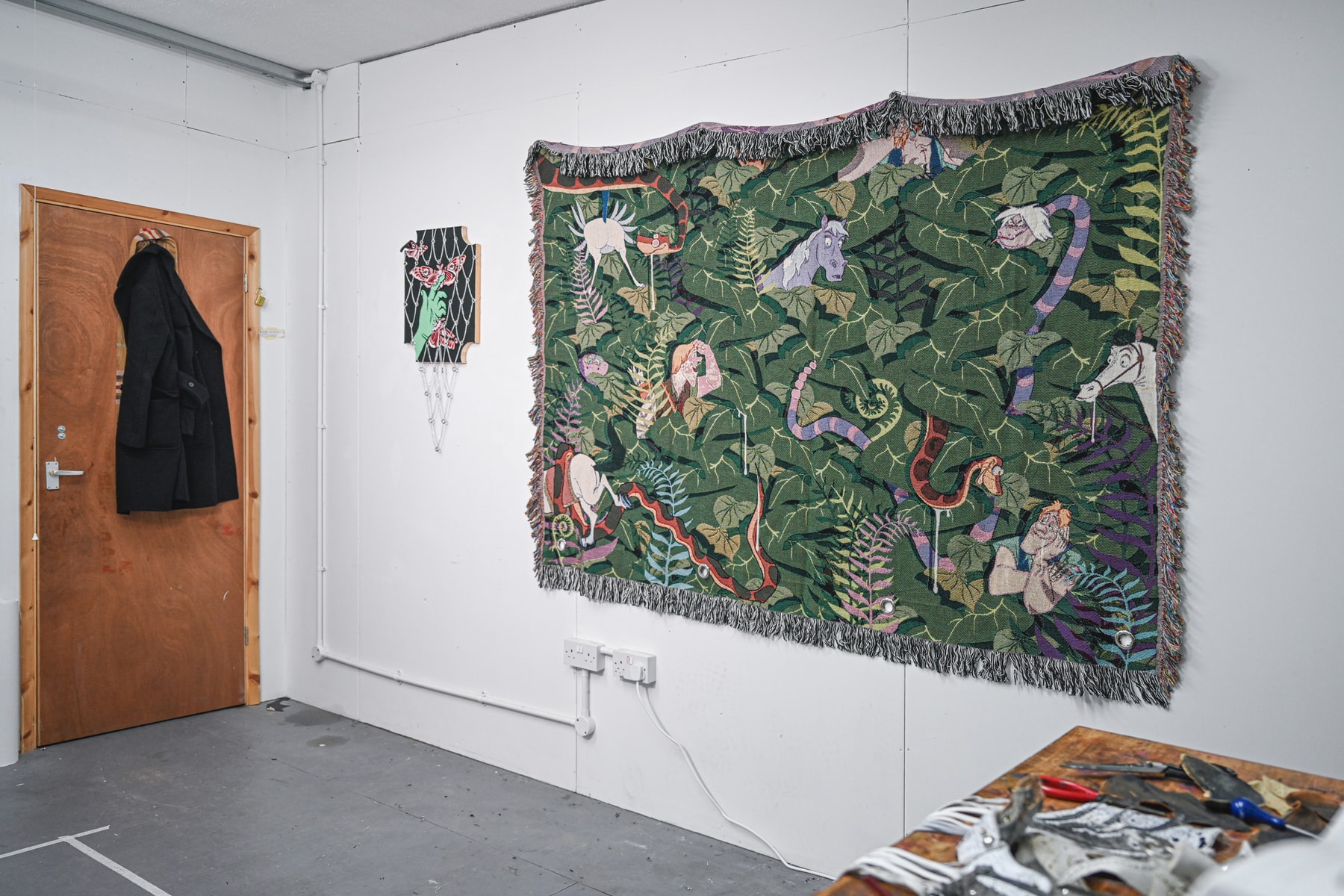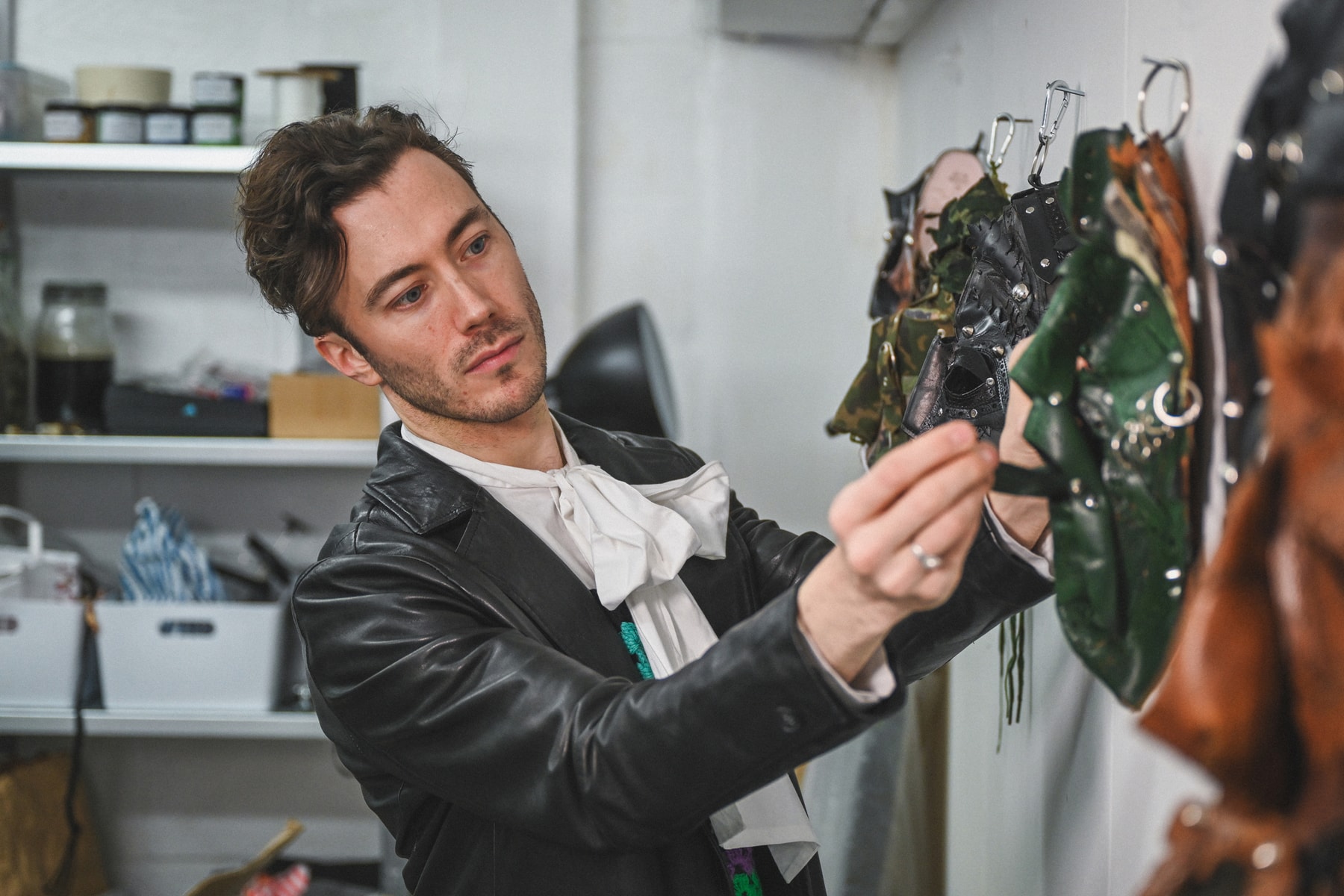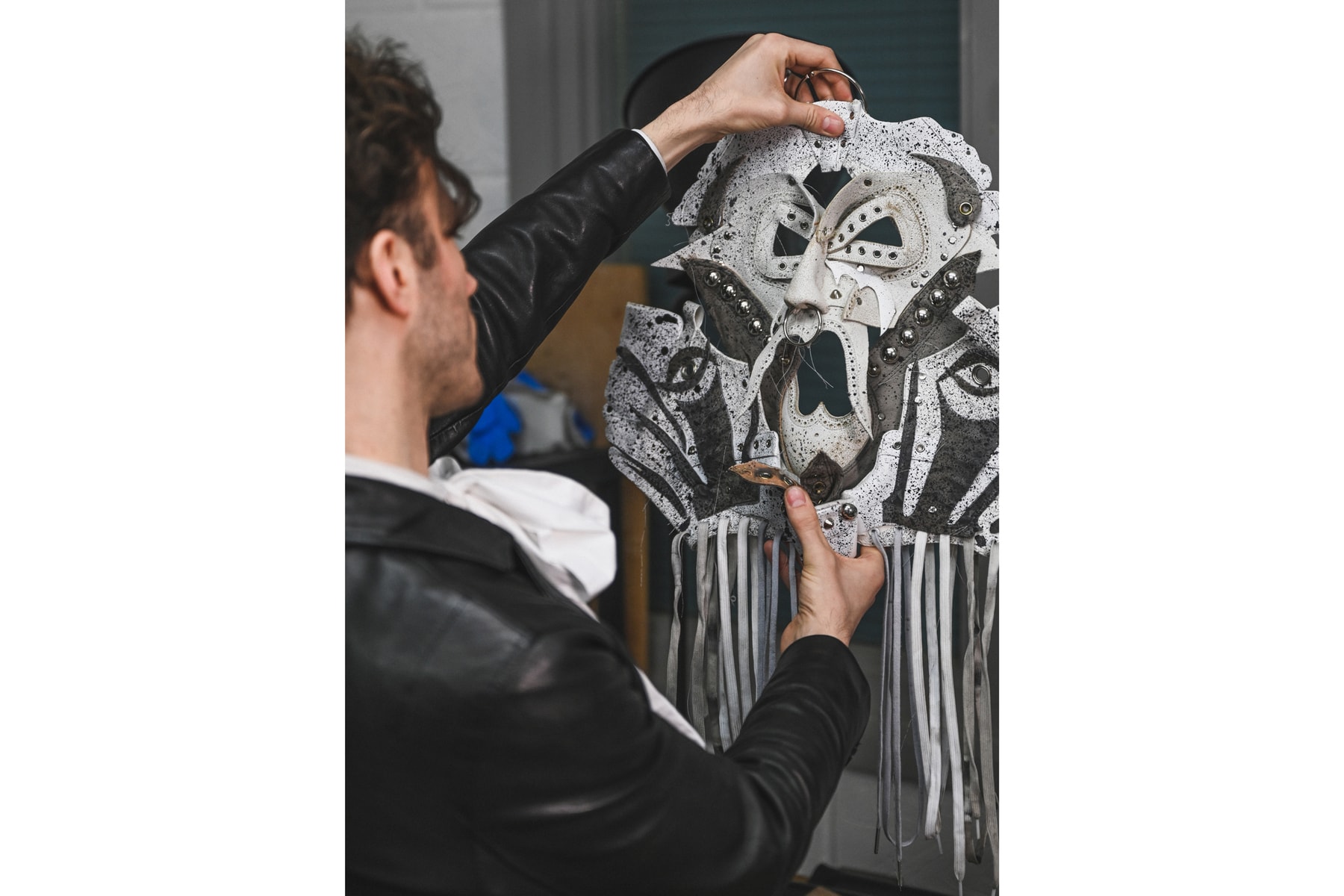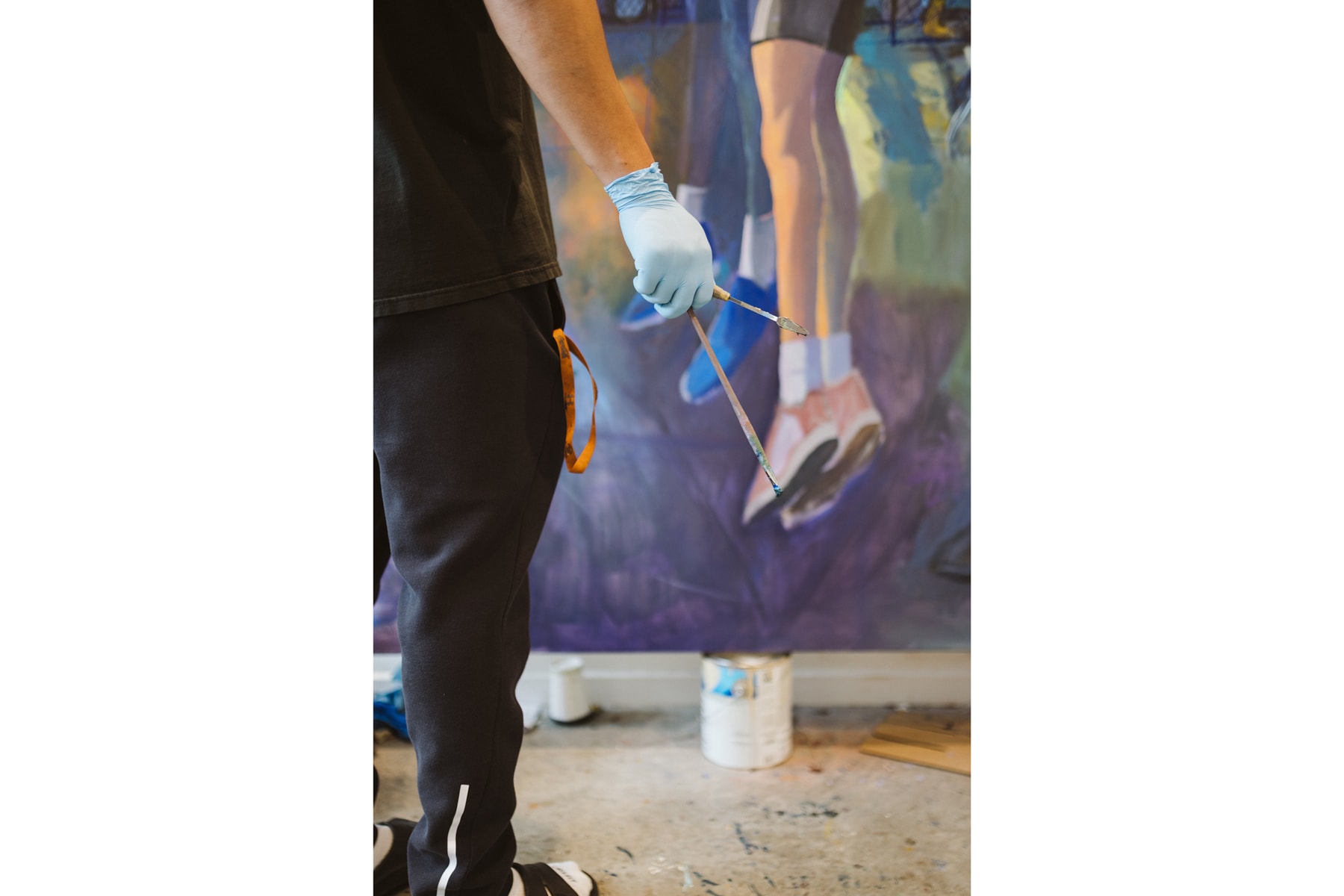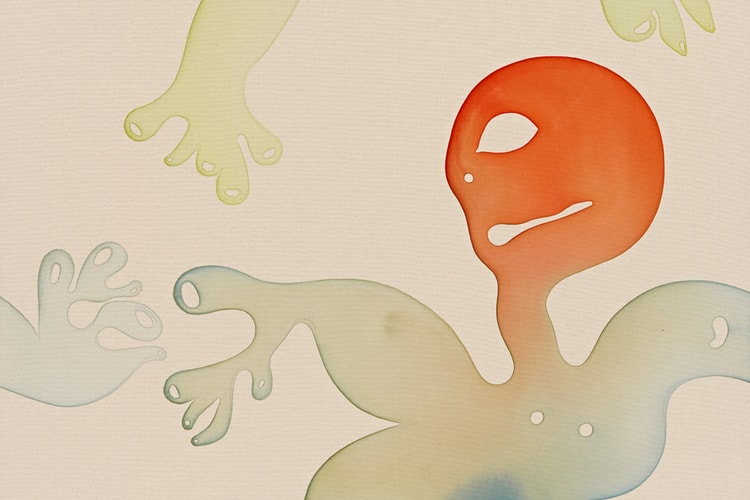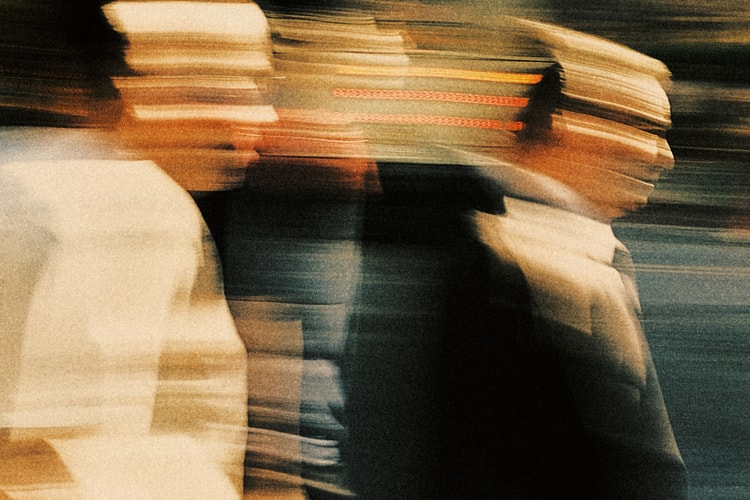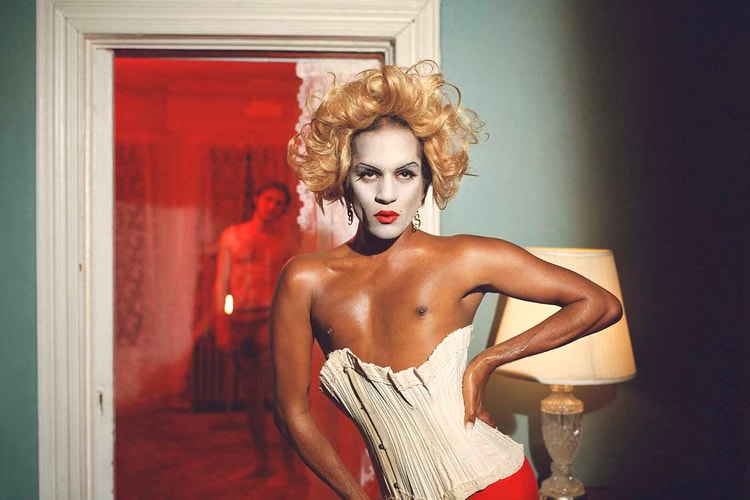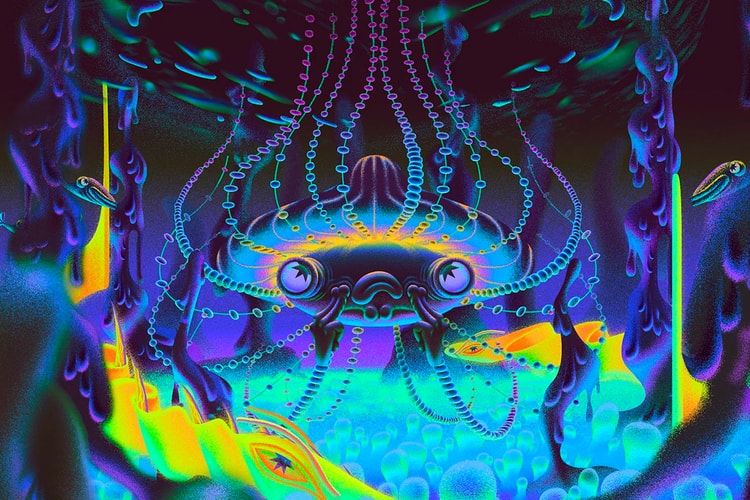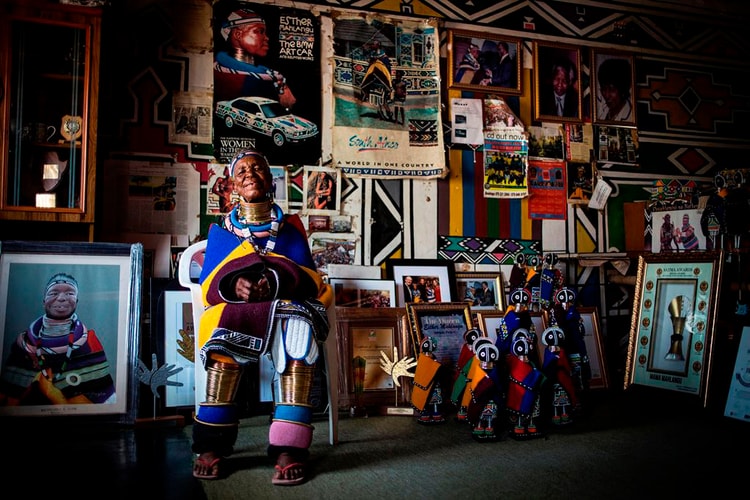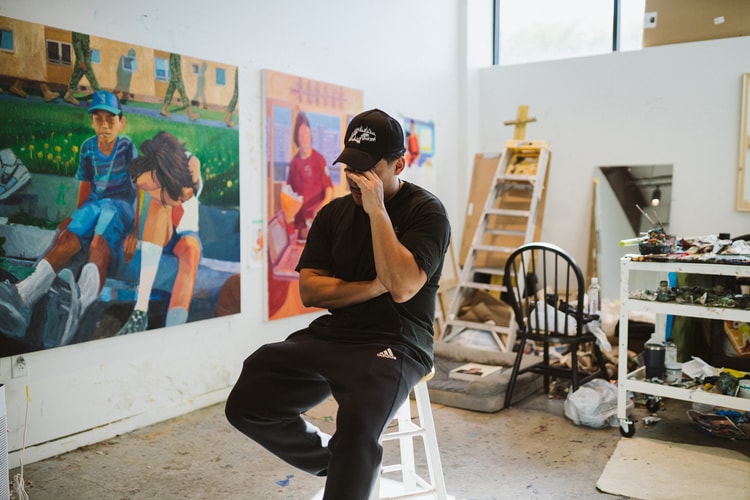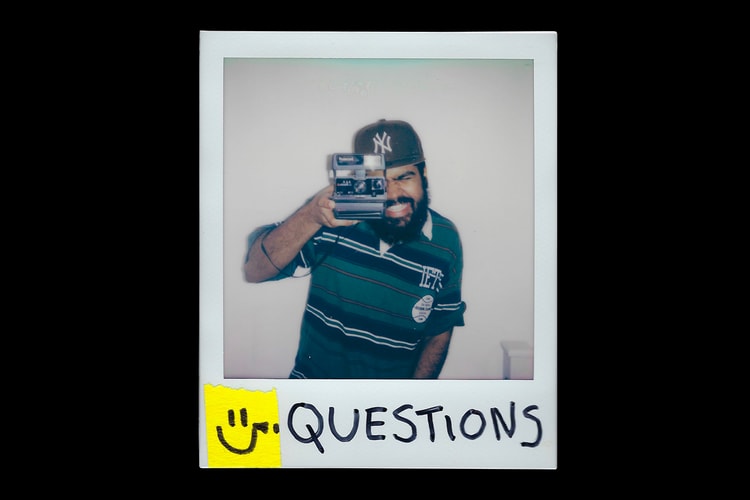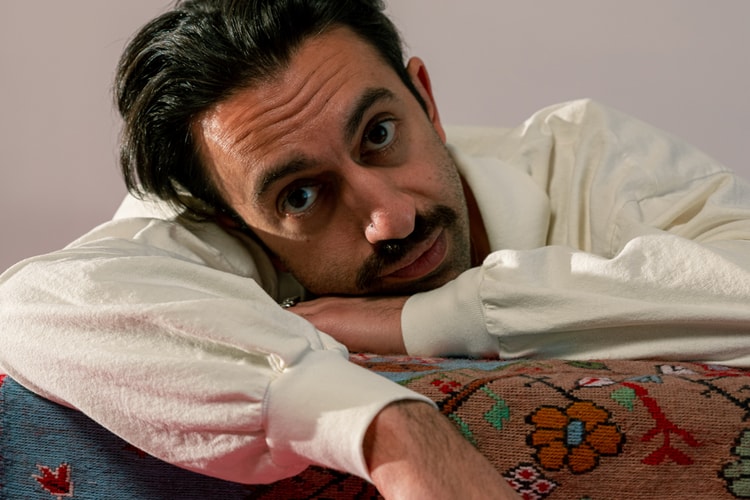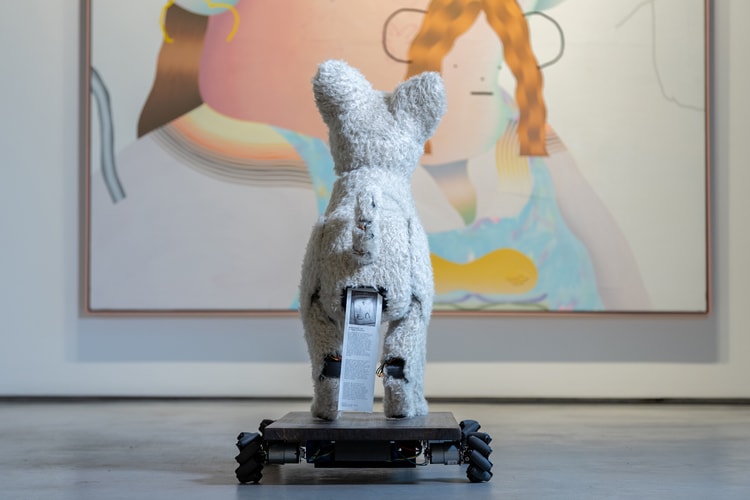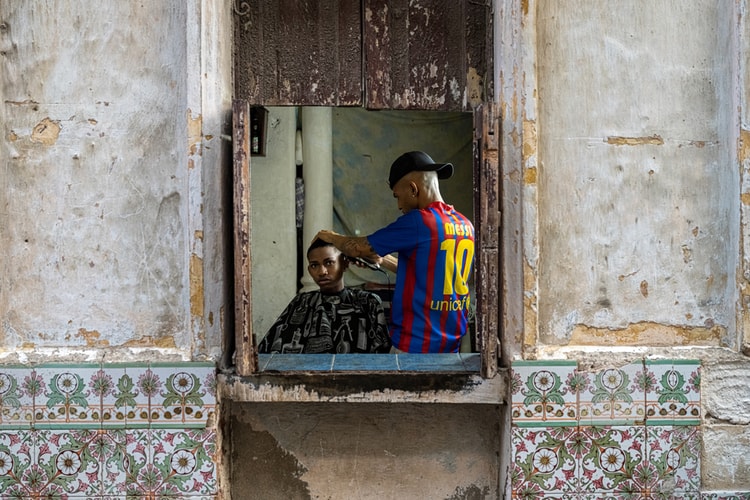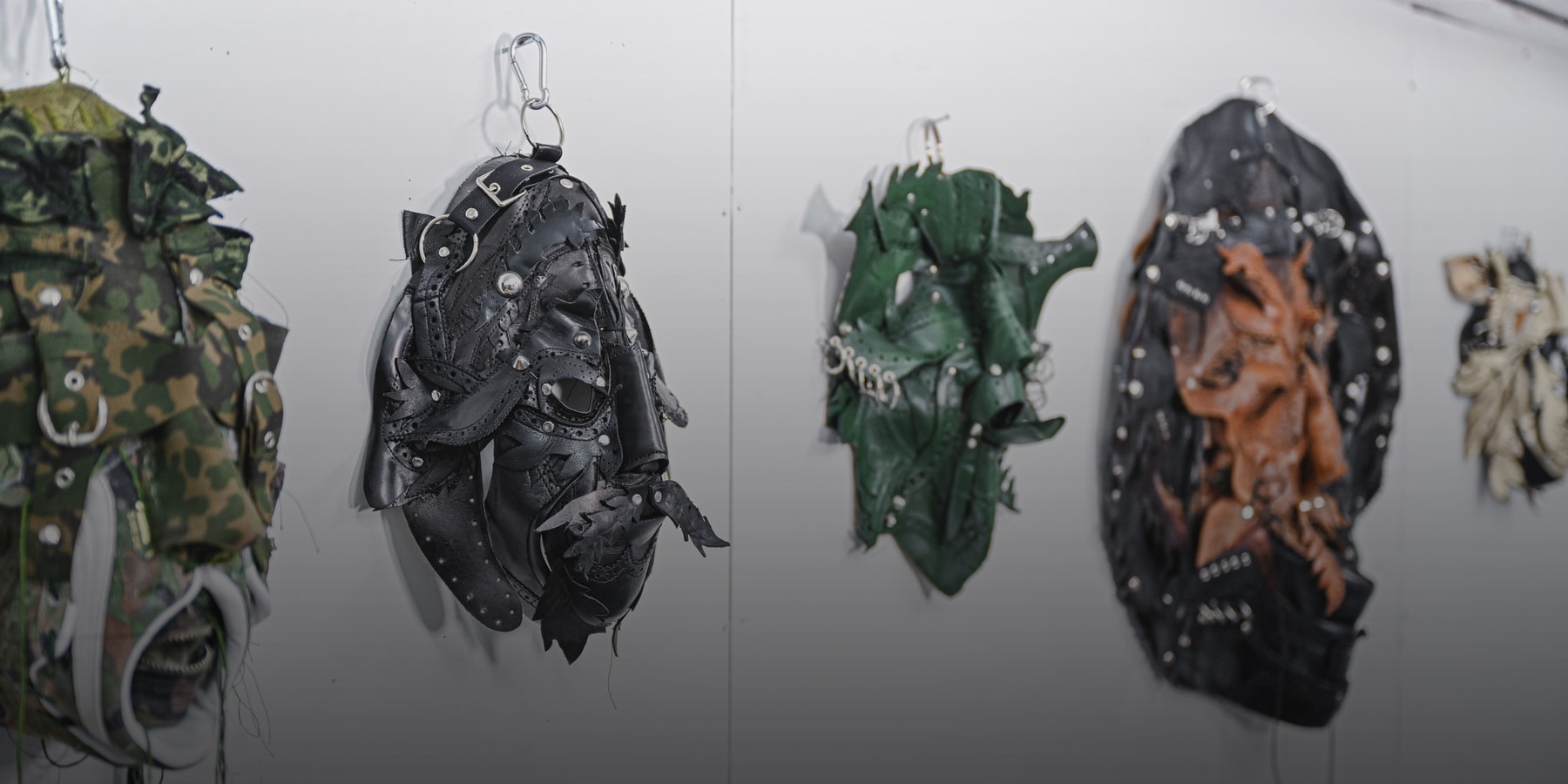
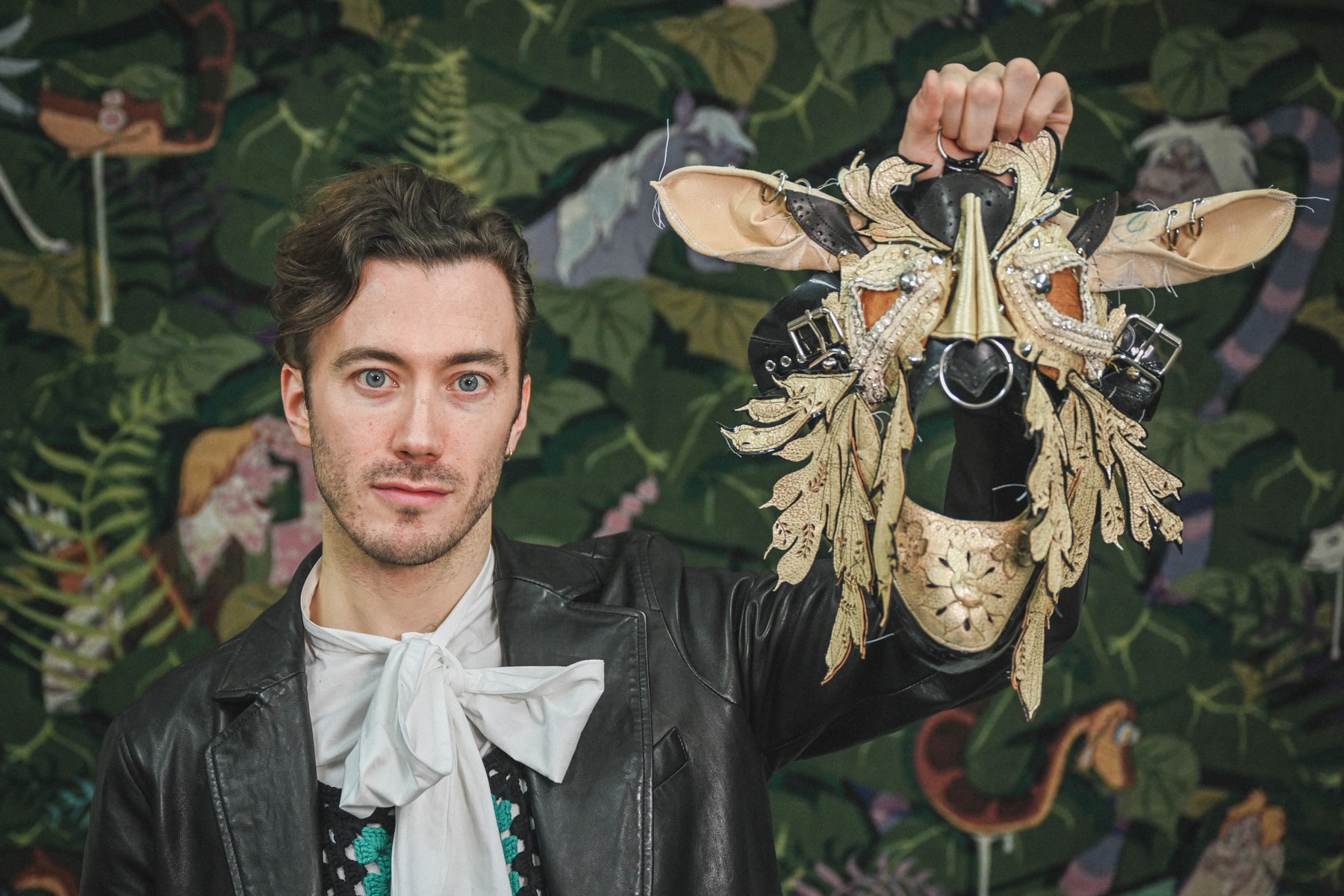
Jakob Rowlinson masterfully blends the natural world with medieval symbolism in his thought-provoking artworks, exploring the evolving perceptions of masculinity. Employing collage techniques and working with felt, he merges decorative patterns inspired by medieval designs and manuscript marginalia with organic iconography. These compositions are enriched by lush green moss, ferns, and foliage, harmoniously blending the natural and the symbolic. Within these captivating landscapes, Rowlinson incorporates contemporary stylized symbols.
Rowlinson’s creative inspiration stems from artbooks and fantasy artwork, including the alluring illustrations found on book covers and video games. Influenced by the Final Fantasy franchise and profoundly moved by Francis Bacon’s emotional portraits, he developed a deep appreciation for art. Working primarily with felt and tapestry, Rowlinson is drawn to their tactile nature and timeless appeal. Felt, in particular, symbolizes both a versatile collage medium and a representation of healing and self-care. By dyeing the felt using natural elements from Hampstead Heath, he establishes a connection to the environment in his work.
Medieval symbols and ornaments hold a significant place in Rowlinson’s compositions, inspired by his fascination with the medieval fantasy genre and its magical past. Influenced by contemporary fantasy fiction and captivated by medieval illuminated manuscripts and gothic architecture, he draws inspiration from the enchanting worlds they portray. As someone who grew up surrounded by medieval symbols, Rowlinson associates them with his queer identity, recognizing their potential as gateways to an alternative past.
Within his artworks, Rowlinson incorporates layered motifs such as barbed wire, arrowheads, and chains, evoking a sense of confinement or imprisonment. By juxtaposing these sharp, masculine symbols with soft fabrics, he challenges traditional associations of violence and toughness. The hand emerges as a recurring motif in Rowlinson’s work, representing an exploration of gender and sexuality. Through expressive gestures and emotions conveyed through hands, he offers nuanced commentary on these fundamental aspects of human identity.
Rowlinson, born in 1990, received his artistic education at the prestigious Ruskin School of Art, studying Fine Art, and pursued an MA in Sculpture at the esteemed Royal College of Art. His talent and unique artistic vision have led to exhibitions at prominent galleries, including Quench Gallery in Margate, Tandsticksmuseet in Sweden, and Clearview in London. In 2022, he was appointed as the Artist-in-Residence at Fores Project in London. Currently based in the vibrant city of London, Rowlinson continues to create captivating artworks that challenge perceptions and invite contemplation. Currently the artist is presenting a new body of work being exhibited at Steve Turner gallery in LA. The show, entitled “Illuminations,” features the artist’s signature leather masks crafted from found materials and suspended from the gallery’s ceiling. Despite their hollow leather faces, they embody a complex range of emotions, evoking desire, passion, and guilt. These masks symbolize an ongoing struggle between the contrasting realms of carnival and lent, presenting a profound exploration of human experiences.
In our most recent installment of ‘Hypeart Visits’, we had the opportunity to engage with Jakob and delve into his multidisciplinary art practice that involves the use of unconventional materials to create fantastical masks and tapestries as well as the challenges he’s faced in the industry as an artist from the LGBTQIA+ community. Take a look at our exclusive interview below.
“Queering the past is a process of healing I think.”
Describe the moment when you wanted to dedicate yourself to a career in contemporary art.
I know it borders on cliché, but I think I’ve always known I wanted to be an artist. One of my earliest memories is from when I was around five years old and I was creating a great big painting of a snow leopard at school. My teacher allowed me to continue the painting over the next few days, and afterwards called me her “little artist”. Since then, one way or another, making art has always been my go to ambition, and although building a career has seemed very difficult at times, I can’t imagine doing anything else.
Tell us about your background. Were you introduced to art in your upbringing? If so, what forms or visuals stuck out to you?
Whilst I had plenty of encouragement at school, I did not come from a creative family. Much of my early inspiration came from artbooks and fantasy artwork, especially illustrations on the covers of books or video games. I used to particularly love the Final Fantasy franchise, and I’m sure that like many other kids, I would make up my own figures and images based on my imagination. As a teenager I was able to go to exhibitions and see art properly. I remember a retrospective of Francis Bacon’s paintings touring near where we lived, and being completely blown away by his portraits of his lover George Dyer. They were so raw and moving that I’m certain they made a deep impression on me as a young person.
The materials in your work predominantly consist of felt and tapestry. What draws you to these materials?
I really enjoy working with fabrics as they are obviously very tactile materials and are familiar to us through fashion, but they can also be quite timeless and enigmatic. One of my favorite artworks is the ‘Hunt of the Unicorn’ in the Met Cloisters, which is a continued source of inspiration for my work. In addition to making tapestries, I also create collage works from felt, which I dye using a range of plants and tree barks that I gather from Hampstead Heath, a famous park near to my house. Felt fabric is a fantastic material for collage as it doesn’t fray when cut. It also has connotations with healing and self-care because it can reform itself when pierced or torn. I like to think of this as a metaphor for ‘queering the past’; so much of LGBTQIA+ history has been erased or covered up that it’s vital to find ways of filling in the blanks. Queering the past is a process of healing I think.
“I draw inspiration from a lot of contemporary fantasy fictions that play with alternative history.”
Medieval symbols and ornaments are prevalent in your compositions. Tell us about your decision to incorporate these motifs in your work.
I’m particularly interested in the medieval fantasy genre and the representation of an imagined, magical past. Fantasy worlds are a place for (re)invention, and I draw inspiration from a lot of contemporary fantasy fictions that play with alternative history. As well as literature, I’m also drawn to the bizarre and beautiful worlds of medieval illuminated manuscripts and gothic architecture, where human figures become hybrid creatures, or plants transform into eggs. I grew up in an area of the UK that has a lot of these medieval symbols and ornaments attached to buildings and architecture. And although it will sound unusual, I think a lot of my queer identity is tied into hearing and seeing these fantastical symbols as a child. If you take a look at medieval costumes, or pay close attention to the grotesques on the side of old cathedrals in Europe, they often have very humorous and bizarre imagery. Michael Camille was a big proponent of viewing these symbols as gateways to a queer past, and so in some way I see these motifs as inherent to my personality and identity.
Depictions of barb wire, arrow heads and chains are often layered on top of your subjects forming what seemingly looks like a prison or cage. What are the messages behind these particular pieces?
To me, chains, arrows, barbed wire, swords etc., all have associations with a certain hyper-masculine aesthetic, or a projected image of violence and toughness. I guess I enjoy the irony of depicting these sharp, penetrating forms of masculinity with soft fabrics and materials. I’m doing something similar with my solo show next year at the Dowse Museum in New Zealand. I am creating a range of ‘Lord of the Rings’ inspired swords, made from rubber and laser cut acrylic, so that will resemble a cross between gay sex toys and weapons from a computer game. And instead of having medieval sounding names (as in many of the swords mentioned in LOTR or from medieval sagas such as ‘Beowulf’), they will each have titles such as ‘sissy boy’ or ‘too sensitive’ etched into the blade; these were childhood slurs, and so I feel there is power in reclaiming these names for these works.
“There is always a lot of movement and play with composition and arrangements before I settle on anything.”
The human hand, seen in various gestures, is a most prominent subject in your practice. What is the importance of the human hand to you?
Yes, hands also feature a lot in my work because I enjoy drawing them but also because of their symbolism. I am a very gestural person and I am always ‘talking with my hands’, as it were. For me, hand gestures are also suggestive of change – the same hand morphing to form new shapes, even as it reminds us of familiar expressions and meanings. So in my mind, my gestures are a sort of archive: these are motions I learned as a child watching Madonna’s Vogue playing on TV, or they are gestures I learned from queer people when I first moved to London. Our gestures form a living link between generations of queer identifying people, even as they manifest in our individual bodies in unique ways.
How do you begin your creative process? Is it sketching out an idea or directly working with the material to create a piece?
Drawing is very central to starting my creative process and I always carry a sketchbook with me wherever I go. However, I am not at all beholden to designs or drawings when I am starting new work, and very rarely does something I’ve drawn in my sketchbook translate into a final artwork. Rather, I work very intuitively with materials, and although I have different media in my practice, ultimately what unifies my work is the process of collage. Whether that’s digital collage or cutting and sewing pieces of fabric – there is always a lot of movement and play with composition and arrangements before I settle on anything. In this way, my creative process is iterative, i.e. it is a constant process of refinement until you arrive somewhere different from your initial ideas. And I find this to be extremely helpful and a very generative process.
Tell us about the atmosphere in your studio while you’re working. Are you listening to any music? Is it silent?
On a day-to-day basis I love listening to podcasts, but I find them too distracting for working in the studio. So instead I’ll just listen to instrumental music or else I will play an old TV show on repeat – the ones that I’ve already watched multiple times – so I can dib in and out without paying much attention to the plot. It’s all about having something on in the background which isn’t actually too distracting.
Is there a source material that you constantly go back to? What are some of your sources of inspiration?
I find it fascinating to look back over old work, perhaps from when I was studying or first moved to London, and see that although many aspects of my practice have changed, I am still interested in similar things: masks, anthropomorphism, Disney characters, the English arts and crafts movement, Aubrey Beardsley, wallpaper patterns, Dance macabre… I have an old photograph of Agamemnon’s death mask that has moved around with me from studio to studio, which I guess neatly summarizes the kind of things I’m interested in.
Are you experimenting with any new materials, subjects or forms in your compositions?
I’m very excited by a new series of leather masks that I’ve made out of recycled shoes studded with key-rings and chains. They take the form of medieval grotesques or ‘green men’ sculptures, often with multiple leaves and bits of leather foliage hanging off them. Visually they are a sort of marriage between contemporary kink community aesthetics, and historical nature mythology. They also have something of a pup/leather play vibe, but hopefully there’s also a more deep rooted debauchery to them as well.
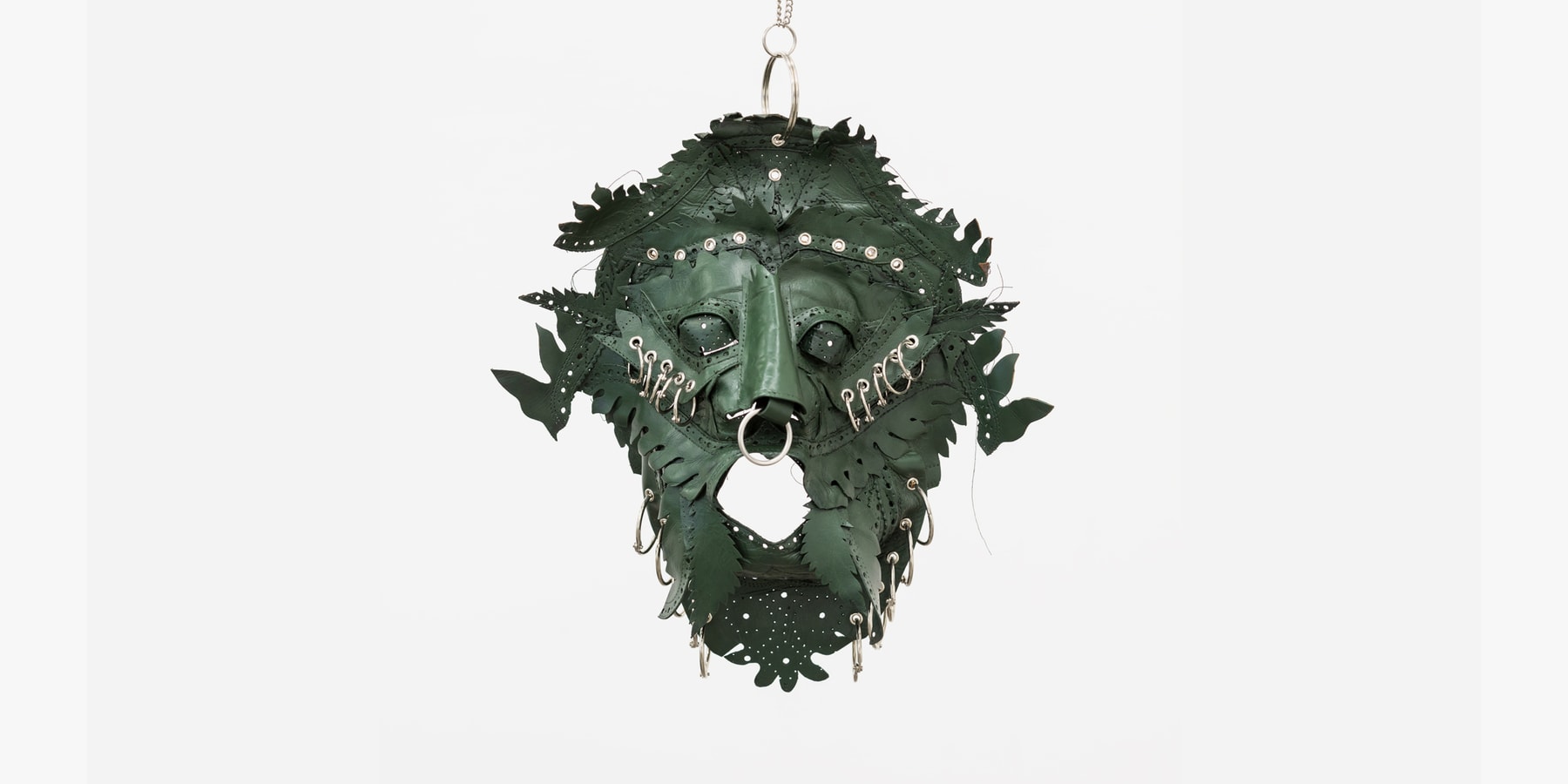
“I don’t want to be categorized as a gay medieval artist.”
You’ve done numerous solo exhibitions. What are some biggest hurdles when it comes to preparing for a show and working with a gallery?
I have been lucky to have several solo shows, and I am currently working on another for next year. The hurdles are always the same though, namely budget and your own anxiety about how the work is progressing in the lead up to the opening. I guess both have gotten easier to manage with more experience, and it is always better to have a relationship with the gallery or the curator so that you can talk through any anxieties or budgeting problems you may be having. Allowing those worries to fuel you and not hold you back is the key.
What are some of the challenges that you face in the industry as an artist from the LGBTQIA+ community?
I cannot stress how fortunate I have been with regards to not facing stigma from the art world, because I know that many other LGBTQIA+ artists experience greater barriers than I do. Something which I find personally challenging though is how to avoid my work being pigeonholed or oversimplified. My artwork blends together a range of contemporary and historical references and so it can be a little overwhelming or esoteric even, especially when viewed online. I don’t want to be categorized as a gay medieval artist.
What advice would you give to aspiring artists that want to create work that challenges the status quo?
That’s a very hard question to answer, especially as I’m not sure I’m qualified to give advice or even that my work challenges the status quo. However, I do make work that I really WANT to make, which means I’m less focussed on directly appealing to the art market and collectors. And I guess that other artists who want to challenge the status quo need to build systems in place to support themselves because making that kind of work is challenging in itself.
Photography courtesy of Eva Herzog exclusively for Hypeart.



